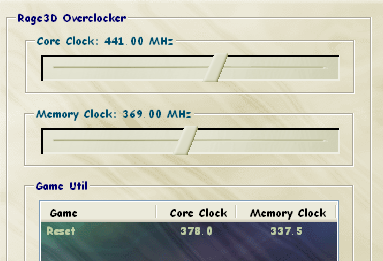Overclocking tests
We've got an enthusiast bias here at Hexus. So after ensuring that the test card performed correctly in an OS environment, the next step was to see how far it would pass its rated specifications. Remember that a 9800 Pro's standard operating frequencies are 380MHz core and 680MHz memory respectively. The latest build of Rage 3DTweak (3.8c) was used to manipulate the card's frequencies.
The Crucial card was set to 1600x1200x32 with 4x AA and 8x AF. These settings would severely load the GPU. 3DMark's Nature test was used as a brief indicator of stability. Once maximum frequencies were gained for both the GPU and memory clocks, the entire benchmark was run three times to ensure basic stability. After a while of testing and resetting, the following frequencies appeared to be generally stable.

441MHz core and 738MHz memory without any additional cooling, and all mounted inside a regular case. 3DMark 2001SE, Quake III and Unreal Tournament 2003 were re-run at 1600x1200x32 with 4x FSAA and 8x AF applied. The following graphs should highlight what effect pushing the card has on selective benchmarks run with a quality bias.
Firstly, 3DMark 2001SE.

Just over a 13% gain here. Not bad. It eclipses the GeForce FX's score with lower clocks (FX Ultra @ 450/850).
Now Quake III

Not quite good enough to topple the FX5900 Ultra.
And now UT2003.

But more than good enough here.









